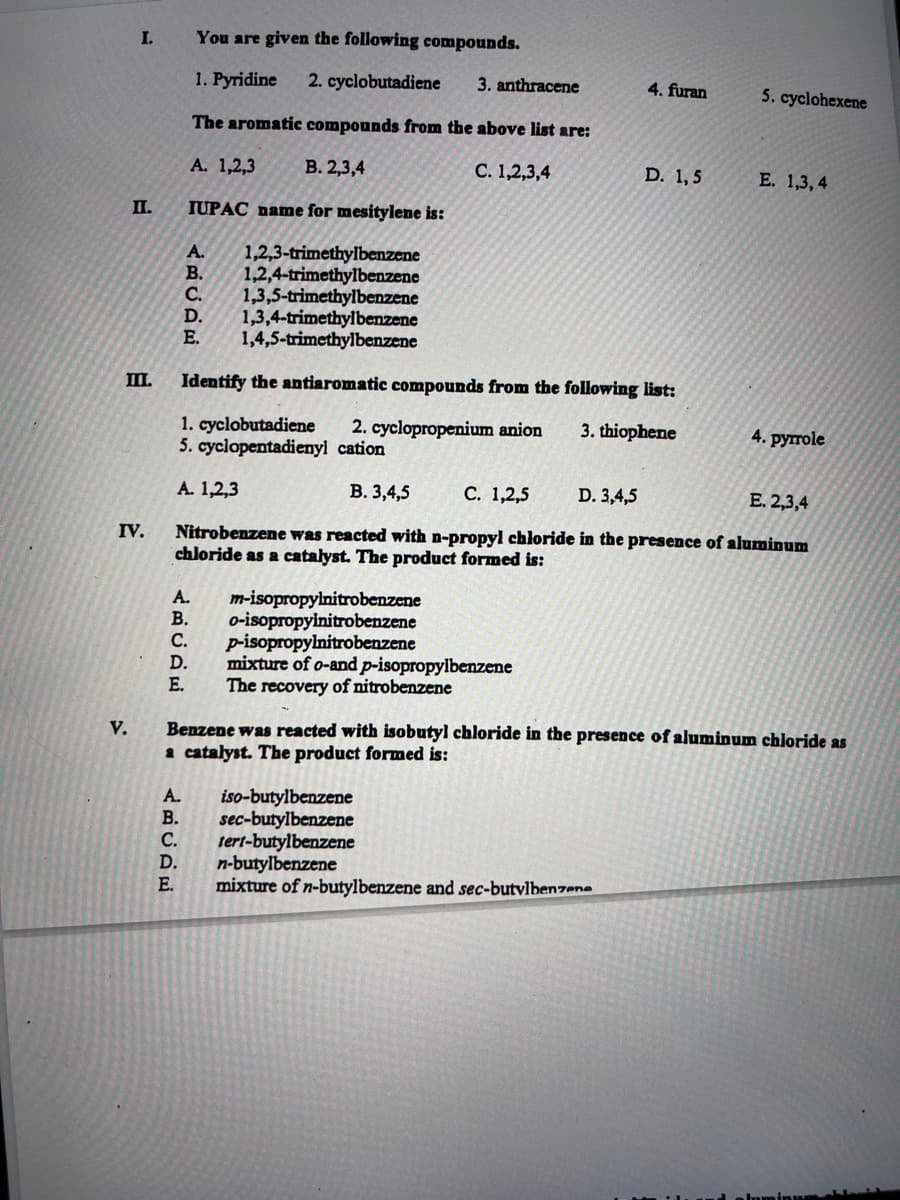You are given the following compounds. 1. Pyridine 2. cyclobutadiene 3. anthracene The aromatic compounds from the above list are: A. 1,2,3 B. 2,3,4 C. 1,2,3,4 4. furan D. 1,5 5. cyclohexene E. 1,3,4
You are given the following compounds. 1. Pyridine 2. cyclobutadiene 3. anthracene The aromatic compounds from the above list are: A. 1,2,3 B. 2,3,4 C. 1,2,3,4 4. furan D. 1,5 5. cyclohexene E. 1,3,4
Organic Chemistry: A Guided Inquiry
2nd Edition
ISBN:9780618974122
Author:Andrei Straumanis
Publisher:Andrei Straumanis
Chapter15: Radical Reactions
Section: Chapter Questions
Problem 11E
Related questions
Question

Transcribed Image Text:I.
II.
III.
V.
IV.
A. m-isopropylnitrobenzene
B. o-isopropyinitrobenzene
You are given the following compounds.
1. Pyridine 2. cyclobutadiene
The aromatic compounds from the above list are:
A. 1,2,3
B. 2,3,4
IUPAC name for mesitylene is:
A.
1,2,3-trimethylbenzene
1,2,4-trimethylbenzene
B.
C. 1,3,5-trimethylbenzene
D. 1,3,4-trimethylbenzene
E. 1,4,5-trimethylbenzene
Identify the antiaromatic compounds from the following list:
3. thiophene
1. cyclobutadiene 2. cyclopropenium anion
5. cyclopentadienyl cation
A. 1,2,3
ABCDE
C. p-isopropylnitrobenzene
D. mixture of o-and p-isopropylbenzene
E.
The recovery of nitrobenzene
A.
B.
C.
3. anthracene
B. 3,4,5
C. 1,2,5
D. 3,4,5
E. 2,3,4
Nitrobenzene was reacted with n-propyl chloride in the presence of aluminum
chloride as a catalyst. The product formed is:
C. 1,2,3,4
iso-butylbenzene
sec-butylbenzene
tert-butylbenzene
D. n-butylbenzene
Benzene was reacted with isobutyl chloride in the presence of aluminum chloride as
a catalyst. The product formed is:
4. furan
D. 1,5
mixture of n-butylbenzene and sec-butylbenzene
5. cyclohexene
E. 1,3,4
4. pyrrole
Expert Solution
This question has been solved!
Explore an expertly crafted, step-by-step solution for a thorough understanding of key concepts.
Step by step
Solved in 2 steps with 1 images

Knowledge Booster
Learn more about
Need a deep-dive on the concept behind this application? Look no further. Learn more about this topic, chemistry and related others by exploring similar questions and additional content below.Recommended textbooks for you

Organic Chemistry: A Guided Inquiry
Chemistry
ISBN:
9780618974122
Author:
Andrei Straumanis
Publisher:
Cengage Learning

Organic Chemistry: A Guided Inquiry
Chemistry
ISBN:
9780618974122
Author:
Andrei Straumanis
Publisher:
Cengage Learning